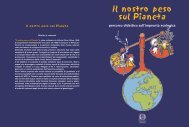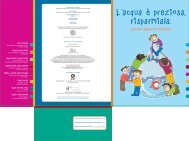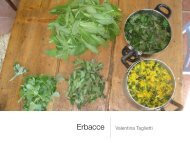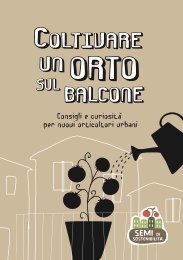Myanmar Protected Areas: Context, Current Status ... - Istituto Oikos
Myanmar Protected Areas: Context, Current Status ... - Istituto Oikos
Myanmar Protected Areas: Context, Current Status ... - Istituto Oikos
You also want an ePaper? Increase the reach of your titles
YUMPU automatically turns print PDFs into web optimized ePapers that Google loves.
3.3 Conclusions and recommendations<br />
Lampi Island Marine National Park preserves important natural and cultural resources. It is the only<br />
protected area of the Myeik Archipelago and the only marine national park of <strong>Myanmar</strong>. The diversity<br />
of marine and terrestrial biodiversity is of significant value at national, international and regional level<br />
(IBA, ASEAN heritage site). A total of fifty globally protected species have been identified so far but it<br />
is likely that further and more detailed surveys inside and outside Lampi Island MNP will lead to more<br />
discoveries. Lampi mangrove forests are the best conserved of <strong>Myanmar</strong> and, possibly, of the region.<br />
Seagrass beds provide a feeding habitat for endangered species such as dugongs and sea turtles. Both<br />
habitats are under threat of degradation. Some 3,000 people depend on the natural resources of Lampi<br />
Island Marine National Park. The current conflicts between resource protection and use by people<br />
need to be addressed in time. Destruction and overexploitation must be prevented by promoting the<br />
participation of all stakeholders in conservation and wise management of resources and encouraging<br />
sustainable revenue-generating activities. If it is set in such a way as successful, the participatory approach<br />
initiated in Lampi Island MNP will be the cornerstone of how <strong>Myanmar</strong> can work to protect its precious<br />
resources and natural environment. The following recommendations are made for the conservation and<br />
sustainable development of the Lampi Island MNP. The conservation and management goals of the<br />
protected area should be realistically achievable in the present situation, considering that, although not<br />
allowed on paper, there are already not only permanent villages and settlements, but many commercial<br />
activities. At present, only Lampi Island is to some extent protected while smaller islands and the marine<br />
side have been left totally unprotected ever since the park designation. A 4-year management plan,<br />
where different uses and limits of use are defined according to different zones, should be prepared and<br />
enacted in time. The creation of a management/advisory committee including representatives of Forest<br />
Department, Navy and Fisheries Department (as recommended by Rabinowitz 1995), as well as civil<br />
society is envisaged to support the park staff in accomplishing the conservation and development goals.<br />
Zoning: total protection should be granted to the main Lampi Island and to priority habitats inside the<br />
park boundaries, for instance mangrove forests, seagrass beds and coral reefs. Sustainable management<br />
of resources in the other minor islands of Lampi Island MNP should be encouraged, starting with the<br />
legalization of existing villages and definition of a land plan. In particular, further expansion of human<br />
settlements should be contained and support to the livelihoods of current settlers should be given<br />
to promote wise resource use and participation in controlling illegal activities, like logging, poaching,<br />
fishing with illegal techniques. Park staff should be permanently allocated to the newly constructed<br />
park office in Makyone Galet for the implementation of the activities according to the management plan,<br />
monitoring key resources and patrolling illegal activities, in particular logging and dynamite fishing.<br />
More research should be conducted to monitor the status of key resources and to fill information gaps,<br />
in particular on coral reefs, sea turtles nesting sites, dugongs, plain-pouched hornbill. Information about<br />
the park should be divulgated to the villages and boats, signs should be installed around the perimeter.<br />
Stakeholder consultations should continue to be organised on a regular basis with attention to gender<br />
and ethnic balance. Collaboration between the park staff and organised groups of villagers should be<br />
encouraged, especially to control illegal logging and fishing, and to regulate the access and use of<br />
water resources. Environmental education should be included in the school programmes and seminars<br />
regularly organised for the communities. Sound waste management should be initiated starting with<br />
cleaning campaigns on the beach and around water springs. Water, energy and health programmes<br />
are needed to address current problems. As recommended by Rabinowitz (1995) and Fischer (1996),<br />
ecotourism should be developed only after park management is in place and in a manner that favours<br />
community-based initiatives. As the only protected area of Myeik Archipelago in the <strong>Myanmar</strong> side,<br />
the site ought to be connected to Surin and Similan MPAs in Thailand within a large transboundary<br />
reserve to apply the Convention on Biological Diversity (CBD) ecosystem approach and accommodate<br />
different land uses and planning needs.<br />
BOX 1<br />
Plain-pouched Hornbill<br />
Plain-pouched Hornbill in Lampi Island MNP (A. Bonetti)<br />
The Plain-pouched hornbill Aceros subruficollis is an endangered species listed as vulnerable in the IUCN<br />
Red List (2010) due to its small and declining population. The main threats are hunting and shrinking of<br />
the preferred habitat, the lowland wet evergreen forest. The species is confined to Southern <strong>Myanmar</strong><br />
and adjacent Thailand, and to northern Malaysia. Historically described (Anderson, 1889) as common<br />
in <strong>Myanmar</strong> and occurring in great numbers in the Myeik Archipelago, being the commonest hornbill<br />
in the area, it was not recorded in <strong>Myanmar</strong> since as far back as 1941 (Smith 1942) and in the Myeik<br />
Archipelago since 1920 (unknown source in BLI 2005). It appears to have undergone a rapid and huge<br />
decline in the last century (Rasmussen in litt. 1999). During the MABR and MEP project surveys in Myeik<br />
Archipelago and Lampi Island MNP (2006-2010), two roosting sites were localized, a major one with<br />
up to 150 individuals in Hornbill Island, and a minor one, comprising 20-25 individuals, on an islet<br />
immediately south of Bo Cho Island. At least one count per year was done at the Hornbill Island roost<br />
from 2006 and 2010, in the period between December and April, recording a maximum of 149 (end of<br />
January 2006) and a minimum of 43 (beginning of December 2010) individuals. More counts at fixed<br />
period should be carried out to understand if the variation in numbers is related to the breeding season<br />
or to a population decline. Furthermore, to assess the conservation status of the species, more surveys<br />
in the whole Myeik Archipelago are needed.<br />
Plain-pouched Hornbill trend in Lampi Island MNP (Source: MABR 2006-2008; MEP 2009-2010)<br />
118 119<br />
N° individuals<br />
160<br />
140<br />
120<br />
100<br />
80<br />
60<br />
40<br />
20<br />
0<br />
3 January<br />
2006<br />
31 January<br />
2006<br />
April<br />
2006<br />
March<br />
2007<br />
March<br />
2008<br />
Survey period<br />
January<br />
2009<br />
In-depth Study of Lampi Island Marine National Park<br />
March<br />
2009<br />
March<br />
2010<br />
December<br />
2010






